#Maiasaura peeblesorum
Explore tagged Tumblr posts
Text

Dinovember 2024 Day 20: The Good Mother - Maiasaura peeblesorum
#paleoart#dinosaur#dinosaurs#paleontology#dinovember#dinovember 2024#maiasaura#paleoartist#dinosaur artwork#dinosaur art#late cretaceous#palaeontology#cretaceous#dinosaur drawing
104 notes
·
View notes
Text
So giving them robo arms to hold their shit has been the best decision ever (info after imgs)
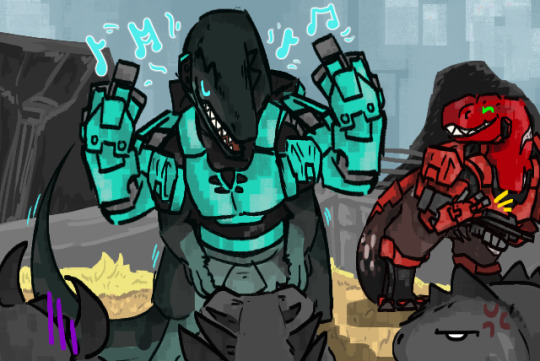
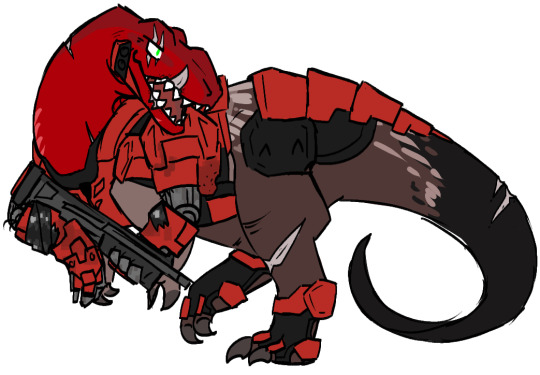
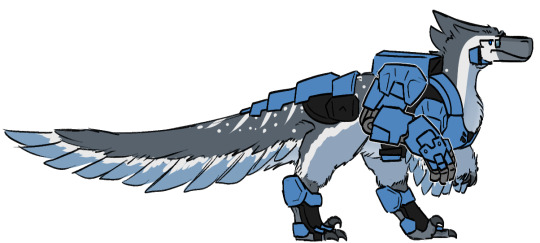
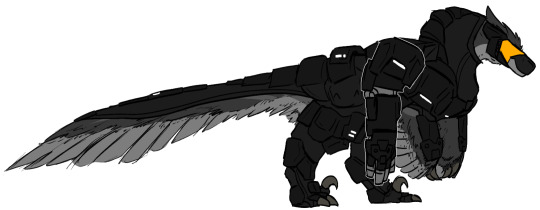
So im going absolutely feral about this AU, so in order to make sure they can still fight their war with guns i gave them robotic arms attached to the thingys on their armour.
Sim Troopers and regular soldiers have about what Church/Sarge wear, while Freelancers and special ops like Locus and Felix are closer to Tex. Hiding specific markings + making them more resilient.
Also please enjoy this height reference I've made (Locus gets honorary Red bc he deserves it). Some heights have been changed to be larger, in Lopez and Tex's case have been drastically changed as they are robots. Nerd stuff about who is what below.

Caboose [Ankylosaurus magniventris]
Church, Carolina, Tex [Utahraptor ostrommaysi]
Washington [Megalosaurus bucklandii]
Tucker [Allosaurus fragilis]
Doc [Kentrosaurus aethiopicus]
Donut [Deinonychus antirrhopus]
Grif, Kaikaina [Pachyrhinosaurus lakustai]
Simmons [Maiasaura peeblesorum]
Sarge [Daspletosaurus torosus]
Lopez [Nasutoceratops titusi]
Locus [Lythronax argestes]
Edit: I forgot Donut and Doc my sons I'm so sorry the bit has breached containment
#RvB Dino AU#dinosaurs#rvb art#rvb church#rvb tex#rvb sarge#red vs blue art#rvb tucker#red vs. blue#dinosaurification ray#the tism
81 notes
·
View notes
Note
ASK AND YOU SHALL RECEIVE
okay why is maiasaura the bestest dinosaur. go
OKAY!! my best defense for maiasaura
1. it's the first dinosaur we found with evidence of actually mothering their young, which was huge at the time. skeletons found with eggs and young next to nests. its a big enough thing that their name literally means "mother lizard " they changed a lot in paleontology
ADDITIONALLY, baby maiasaura fossils show their legs were not fully developed at birth but they still have teeth worn which means their parents brought them food. instead of sitting on eggs they used the heat from rotting vegetation to warm them. and i think thats so so cool
2. they lived in HUGE herds with like 100 animals. they're kinda like cattle to me. big animal in big groups. anyways it would be so so cool to see those we usually dont associate dinosaurs with big groups like that i think
3. they're duck billed dinosaurs, which usually have crests, but they're bald..and it's silly looking.. and also they're really pretty.. in a weird ugly way..

^ ( looking ass...
4. i just think they're neat. yeah honestly thats it i just think they're neat
5. the only representative species has the name of maiasaura peeblesorum. which i think just says something on its own i dont need to elaborate. peeblesorum
7 notes
·
View notes
Text
Maiasaura peeblesorum
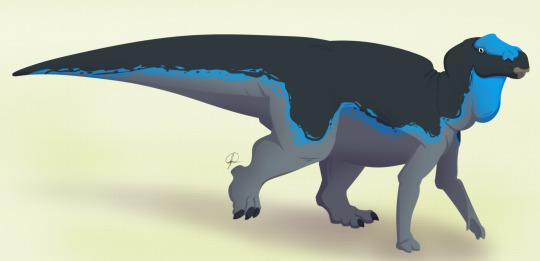
By José Carlos Cortés
Etymology: Good Mother Reptile
First Described By: Horner & Makela, 1979
Classification: Dinosauromorpha, Dinosauriformes, Dracohors, Dinosauria, Ornithischia, Genasauria, Neornithischia, Cerapoda, Ornithopoda, Iguanodontia, Dryomorpha, Ankylopollexia, Styracosterna, Hadrosauriformes, Hadrosauroidea, Hadrosauromorpha, Hadrosauridae, Euhadrosauria, Saurolophinae, Brachylophosaurini
Status: Extinct
Time and Place: Between 77.2 and 76.3 million years ago, in the Campanian of the Late Cretaceous

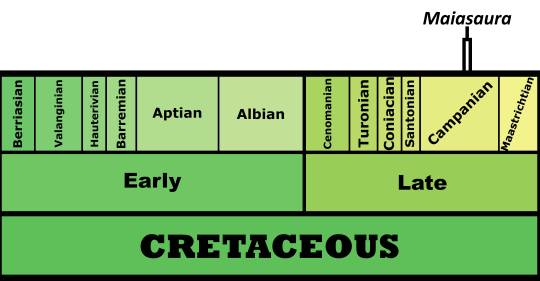
Maiasaura is known from the Upper member of the Two Medicine Formation in Montana
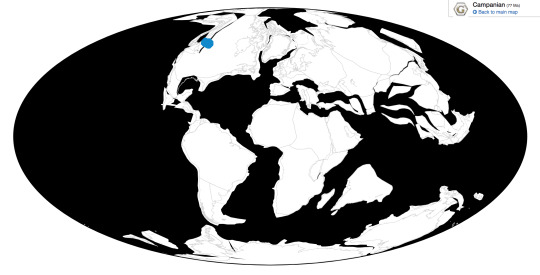
Physical Description: Maiasaura was a medium-sized hadrosaur - aka, a “duck-billed” dinosaur. Famed for being known from hundreds of individual skeletons, we have a general idea of the appearance of this dinosaur at every stage of its life cycle. Baby Maiasaura were around 0.4 meters in length and were positively tiny in weight, weighing less than 250 kilograms. These babies were adorable in appearance: with large eyes, small heads, and small limbs. The limbs were very weak and skinny at this point in life. Despite this extremely small size, Maiasaura young grew quickly - growing to 1.5 meters in length by the first year, and reaching sexual maturity at about the age of three or so, when they weighed around 1250 kilograms. Full skeletal maturity then came at about five years of age. At this point, Maiasaura were as much as 3000 kilograms in weight, and reaching 9 meters in length. Maiasaura adults were much beefier than the young - with thick, strong hind legs and somewhat more gracile front legs, it was almost as if they had deer front legs and elephant hind legs. The front feet formed hoof-like structures - with the pinky and thumb both sticking out, the middle three fingers were fused together. The hind limbs were typical ornithopod feet, with three toes splayed out like that of a very thick bird. Their tails were thick and muscular, and their torsos also very beefy. They had very thick, muscular necks as well.
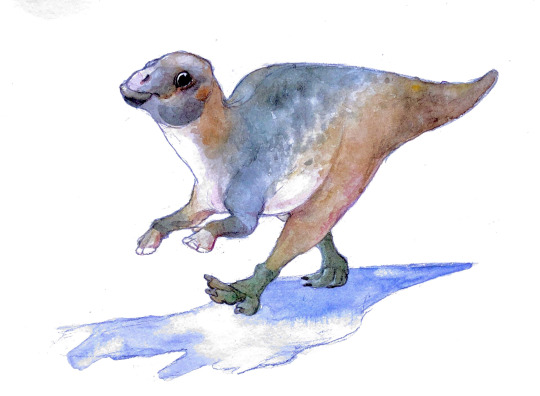
By Ripley Cook
The heads of Maiasaura were rectangular and long, with flattened duck bills in the front. In the jaws, there were rows upon rows of densely packed teeth, forming a single surface. This surface was essentially serrated with the number of teeth packed in there. The upper jaws could then expand, allowing the lower jaws to slide upwards into them, creating a chewing motion. The more duck-like front bill was used to snip off plants and bring them into the jaw. Maiasaura also had a very large nose, forming a sort of lump in the front of the snout - this would have helped keep the head cool, and also allowed Maiasaura to make a variety of calls without a hollow crest attached. Above the eyes the skull of Maiasaura was domed with the brain area. In front of the eyes, on the top of the skull, there was a little ridged crest for display. It is logical to suppose that said crest would be somewhat patterned or even colorful, for display.
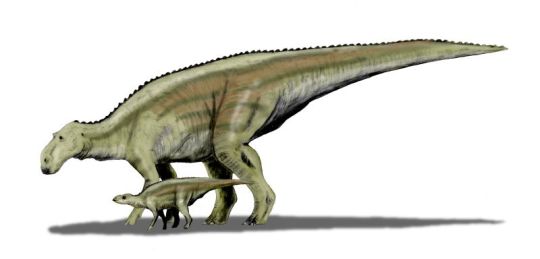
By Nobu Tamura, CC BY 3.0
Scale impressions from Maiasaura are known. Adults of this species were entirely scaley, with almost a pebble-like texture of scales covering the entire body. These small round patches didn’t seem to overlap much, but were densely packed and not leaving much in the way of bare skin showing. Very small ones no longer than 2 millimeters were interspersed with bigger, more hexagonal ones at five to ten millimeters long. It is possible that fuzz would extend between the scales, but they would have looked rather like plants growing between sidewalk scales, and fairly impossible to see ultimately. The back was bumpy from the spine, and rather high over the animal - making Maiasaura itself quite tall. The scales were even bigger on this portion of the animal. Though skin impressions are known from Maiasaura adults and close relatives, baby Maiasaura do not have preserved skin impressions. What this means is that, while it seems very logical they’d also be scaly, there is a possibility they were fluffy to stay warm, given their smaller size. We present one hypothetical reconstruction of such for you all below, with the caveat that it is purely speculation at this time.
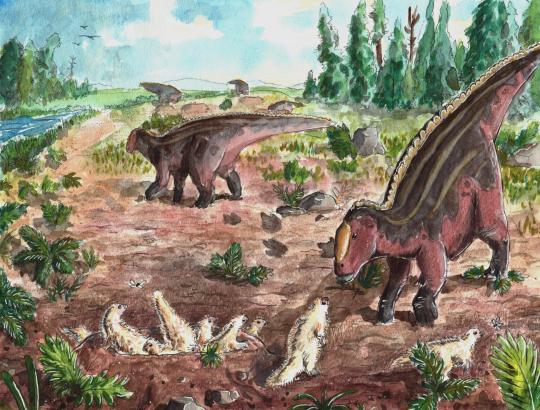
By Diane Ramic
Diet: Maiasaura, like other hadrosaurs, fed mainly on soft, wet vegetation at low and middle levels of browsing (rather more tough, hard, dry vegetation like scrub plants and desert brush). So, it would favor leaves, berries, and more tender shoots, as well as plants in sources of water.
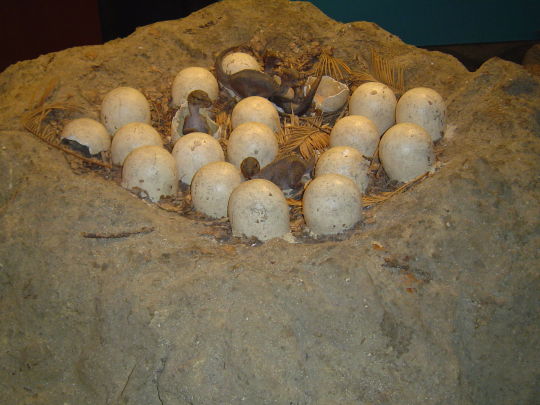
By Madchester, in the Public Domain
Behavior: Maiasaura was a highly social, active animal - warm blooded in energy levels, these dinosaurs would have spent most of their time, each and every day, wandering around looking for food and socializing with other members of the herd. They spent a good portion of their time taking care of their young, of course, but that was only during the breeding season. Nests were made in large breeding colonies, not unlike their modern bird relatives such as seabirds, with gaps between nests only 7 meters long - less than the length of the adults that had to move between them! Between thirty and forty eggs were laid in a dense spiral pattern, and these eggs were the size of an ostrich’s today. Rotting vegetation was placed upon the nest to keep it warm. The babies, not able to take care of themselves upon hatching, entirely relied on their parents to bring them back chewed up food and look out for their safety. Sadly, most of the young would still die in the first year of life - mainly due to disease and predation, up to 90% of the young would die in the first year of life. Still, the parents did their best - with the young having features associated with cuteness, indicating dependence on the parents for survival until they reached larger sizes.

By Debivort, CC BY-SA 3.0
Past that point, however, as the young grew faster, they fared better in terms of mortality - dropping down to 12% mortality until reaching old age again. They began to move on their own and keep up with the herd as it moved about. Young Maiasaura would walk on two legs, and as they got heavier they would switch to four, still sometimes only using the hind limbs when needed. Upon reaching sexual maturity at around three years of age, they began to get even bulkier. The Maiasaura would live in herds hundreds of individuals large, which would have been very noisy - using those bulky nostrils to make very loud, differing calls. Come mating time, they would display to each other with the ridges on their heads and other patterns. It is uncertain who was in charge of caring for the young, as sexual dimorphism isn’t seen in the skeletons of Maiasaura - if it was just the mother, both parents, just the father, or even the parents and previous children, we do not know at this time. The herd structure would protect the young, the sick, and the old from predators, and they would probably call to each other to ensure that they stayed safe in the face of predation. That being said, most of the rest of Maiasaura would then die in old age, with the death rate jumping up to 44% at the oldest ages of 12 to 14, when their own weight, slowness, and illness would leave them more vulnerable to predators.
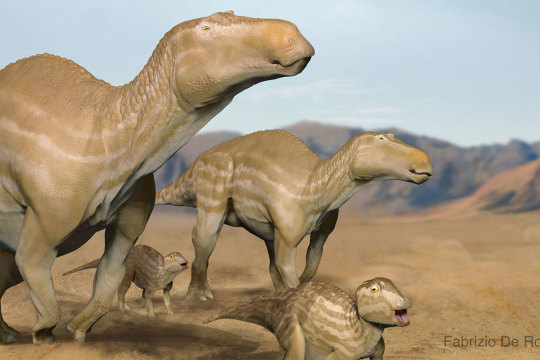
By Fabrizio De Rossi, retrieved from Earth Archives
Ecosystem: The Two Medicine Formation was one of the most iconic dinosaur ecosystems of all time, sort of a precursor in many ways to the more famous Hell Creek, but with more variety and dinosaur diversity! Here was a very large floodplain, filled with rivers and deltas and associated plantlife on sandy riverbanks. This environment was highly associated with the ever-present Western Interior Seaway, much like the later Hell Creek. It was seasonally arid, with rainshadows from the nearby Cordilleran Highlands, which may have been at least somewhat volcanic. This made the Two Medicine Environment positively volatile - with flash flooding, droughts, dehydration, and volcanic activity all allowing for the animals in this region to be wonderfully preserved (allowing us to know so much about Maiasaura)! Plants would grow very rapidly each wet season, making the area a very lush habitat for about half the year, allowing for all these dinosaurs to congregate here. This environment was filled with conifers and pine trees primarily, though there were also other types of plants as well. There were non-dinosaurs here as well - the pterosaurs Montanazhdarcho and Piksi, the Choristodere Champsosaurus, unnamed crocodylians, lizards like Magnuviator, mammals such as Cimexomys, Paracimexomys and Alphadon, and a wide variety of turtles like Basilemys.
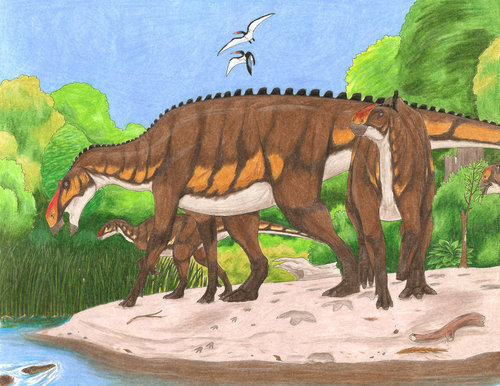
By Sam Stanton
Still, dinosaurs were the primary feature of the later (Upper) Two Medicine environment where Maiasaura frequented. There were four different types of Ceratopsians: the flat-nosed Achelosaurus, the curved-horned Einiosaurus, the giant-horned Rubeosaurus/Styracosaurus (depending on who you talk to, lumping-wise), and the small herbivore Prenoceratops. Ankylosaurs came in three different varieties - the large-spined but wiggle-taled Edmontonia, and the wide tail-clubbed Dyoplosaurus and Scolosaurus. Other hadrosaurs shared this environment with Maiasaura, like the large-nosed Gryposaurus, the round-crested Hypacrosaurus, and the small pointed crest having Prosaurolophus. There was also the small, active burrower Orodromeus. As for theropods, there were two different raptors - Bambiraptor and Richardoestesia - which would have been major problems for younger Maiasaura and the babies and eggs. The predatory opposite-bird, Gettyia, would have also been a predator of these smaller individauls. The troodontid Saurornitholestes would have been a major danger to these young Maiasaura along with its close cousins. The adults, on the other hand, had not one but two different species of tyrannosaur to contend with: the bulky and rarer Daspletosaurus, and the more slender Gorgosaurus that has been hypothesized to feed more on hadrosaurs than its cousin (though this is under hot debate). In short, this was the place to be to see just how diverse and fascinating non-avian dinosaurs were right at the end of their tenure, and Maiasaura was a major part (if not the most common part) of that ecosystem.
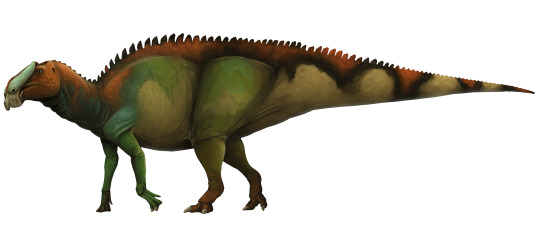
By Scott Reid
Other: Maiasaura is the closest thing non-avian dinosaurs get to a “model organism” - a creature with enough specimens, research, and data about it to use it as an example for other animals which we know less about. With hundreds of specimens found and counting, we have recorded a complete growth sequence of this dinosaur, knowing what the trajectory of a typical Maiasaura life was like. This is of vital importance, as hadrosaurs were some of the most diverse dinosaurs at the end of the Cretaceous - the end of the time of non-avian forms. It is also fascinating for how much the life history of Maiasaura - a dinosaur not close to being a bird by any stretch of the imagination - is so similar to birds. With similar rapid growth rates as their warm-blooded cousins, and similar nesting and group living strategies, Maiasaura showcases how complex behavior and lifestyles were common over the entirety of the dinosaur group. Maiasaura is also of fundamental importance because, with its discovery and descriptions in the late 1970s, it served with Deinonychus to show how dinosaurs weren’t slow, sluggish, giant lizards - but active, warm-blooded avian precursors. Dinosaurs were active, behaviorally complex, and took care of their young - something that was a truly revolutionary statement before these dinosaurs were named! So, despite not really looking like much, Maiasaura is probably one of the most important dinosaur discoveries ever found. Maiasaura itself is closely related to dinosaurs such as Brachylophosaurus, and is in general part of the “crestless” hadrosaur group, along with the contemporary Gryposaurus and the later Edmontosaurus.
~ By Meig Dickson
Sources under the Cut
Arbour, Victoria M.; Currie, Philip J. (8 May 2013). "Euoplocephalus tutus and the Diversity of Ankylosaurid Dinosaurs in the Late Cretaceous of Alberta, Canada, and Montana, USA". PLOS ONE. 8 (5): e62421.
Atterholt, J.; J. Howard Hutchison; Jingmai K. O’Connor (2018). "The most complete enantiornithine from North America and a phylogenetic analysis of the Avisauridae". PeerJ. 6: e5910.
Bailleul, A. M., B. K. Hall, and J. R. Horner. 2013. Secondary cartilage revealed in a non-avian dinosaur embryo. PLoS ONE 8(2):e56937:1-5
Bell, P. R. 2014. A review of hadrosaurid skin impressions. In D. A. Eberth & D. C. Evans (ed.), Hadrosaurs 572-590
Bell, P. R., R. Sissons, M. E. Burns, F. Fanti, and P. J. Currie. 2014. New saurolophine material from the upper Campanian-lower Maastrichtian Wapiti Formation, west-central Alberta. In D. A. Eberth & D. C. Evans (ed.), Hadrosaurs 174-190
Bonaparte, J. F., Novas, F. E., & Coria, R. A. (1990). Carnotaurus sastrei Bonaparte, the horned, lightly built carnosaur from the Middle Cretaceous of Patagonia. Contributions in Science. Natural History Museum of Los Angeles County, 416, 1-42.
Campione, N. E., K. S. Brink, E. A. Freedman, C. T. McGarrity, and D. C. Evans. 2013. ‘Glishades ericksoni’, an indeterminate juvenile hadrosaurid from the Two Medicine Formation of Montana: implications for hadrosauroid diversity in the latest Cretaceous (Campanian-Maastrichtian) of western North America. Palaeobiodiversity and Palaeoenvironments 93:65-75
Carr, Thomas D.; J. Varricchio, David; C. Sedlmayr, Jayc; M. Roberts, Eric; R. Moore, Jason (30 March 2017). "A new tyrannosaur with evidence for anagenesis and crocodile-like facial sensory system". Scientific Reports. 7: 1–11.
Carroll, R. L.. 1988. Vertebrate Paleontology and Evolution 1-698
Carroll, N. REASSIGNMENT OF MONTANAZHDARCHO MINOR AS A NON-AZHDARCHID MEMBER OF THE AZHDARCHOIDEA, SVP 2015.
Chapman, R., and M. K. Brett-Surman. 1990. Morphometric observations on hadrosaurid ornithopods. In K. Carpenter and P. J. Currie (eds.), Dinosaur Systematics: Perspectives and Approaches, Cambridge University Press, Cambridge 163-177
Chinnery, Brenda J.; Horner, John R. (2007). "A New Ceratopsian Dinosaur Linking North American and Asian Taxa". Journal of Vertebrate Paleontology. 27 (3): 625–641.
Cruzado-Caballero, P., X. Pereda-Suberbiola, and J. I. Ruiz-Omeñaca. 2010. Blasisaurus canudoi gen. et sp. nov., a new lambeosaurine dinosaur (Hadrosauridae) from the latest Cretaceous of Arén (Huesca, Spain). Canadian Journal of Earth Sciences 47:1507-1517
Cruzado-Caballero, P., and J. E. Powell. 2017. Bonapartesaurus rionegrensis, a new hadrosaurine dinosaur from South America: implications for phylogenetic and biogeographic relations with North America. Journal of Vertebrate Paleontology 37(2):e1289381:1-16
Cubo, Jorge; Woodward, Holly; Wolff, Ewan; Horner, John R. (2015). "First Reported Cases of Biomechanically Adaptive Bone Modeling in Non-Avian Dinosaurs". PLoS ONE. 10 (7): e0131131.
Currie, Trexler, Koppelhus, Wicks and Murphy (2005). "An unusual multi-individual tyrannosaurid bonebed in the Two Medicine Formation (Late Cretaceous, Campanian) of Montana (USA)." P.p. 313-324 in Carpenter, K. (ed.), The Carnivorous Dinosaurs. III. Theropods as living animals.
Czerkas, S. A. (1992). Discovery of dermal spines reveals a new look for sauropod dinosaurs. Geology, 20(12), 1068-1070.
D’Emic, M. D. 2015. Comment on “Evidence for mesothermy in dinosaurs.” Science 348 (6238): 982.
Davis, M. (2012). Census of dinosaur skin reveals lithology may not be the most important factor in increased preservation of hadrosaurid skin. Acta Palaeontologica Polonica, 59(3), 601-605.
Dilkes, D. W. 1999. Appendicular myology of the hadrosaurian dinosaur Maiasaura peeblesorum from the Late Cretaceous (Campanian) of Montana. Earth and Environmental Science Transactions of the Royal Society of Edinburgh 90 (2): 87 - 125.
Dilkes, D. W. 2001. An ontogenetic perspective on locomotion in the Late Cretaceous dinosaur Maiasaura peeblesorum (Ornithischia: Hadrosauridae). Canadian Journal of Earth Sciences, 38(8), 1205-1227.
Dodson, P. 1975. Taxonomic implications of relative growth in lambeosaurine hadrosaurs. Systematic Zoology 24:37–54.
Dodson, Peter & Britt, Brooks & Carpenter, Kenneth & Forster, Catherine A. & Gillette, David D. & Norell, Mark A. & Olshevsky, George & Parrish, J. Michael & Weishampel, David B. The Age of Dinosaurs. Publications International, LTD. p. 116-117.
Dodson, P., C.A. Forster, and S.D. Sampson. 2004. Ceratopsidae in Weishampel, D.B., P. Dodson, and H. Osmolska (eds.) The Dinosauria. 2nd Edition, University of California Press.
Farke, A. A., D. J. Chok, A. Herrero, B. Scolieri, and S. Werning. 2013. Ontogeny in the tube-crested dinosaur Parasaurolophus (Hadrosauridae) and heterochrony in hadrosaurids. PeerJ 1:e182.
Farlow, James O.; Pianka, Eric R. (2002). "Body size overlap, habitat partitioning and living space requirements of terrestrial vertebrate predators: implications for the paleoecology of large theropod dinosaurs". Historical Biology. 16 (1): 21–40.
Federico L. Agnolin & David Varricchio (2012). "Systematic reinterpretation of Piksi barbarulna Varricchio, 2002 from the Two Medicine Formation (Upper Cretaceous) of Western USA (Montana) as a pterosaur rather than a bird" (PDF). Geodiversitas. 34 (4): 883–894.
Forster, C. A., and P. C. Sereno. 1994. Phylogenetic analysis of hadrosaurid dinosaurs. Journal of Vertebrate Paleontology 14(3, suppl.):25A
Forster, C. A. 1997. Hadrosauridae. In P. J. Currie & K. Padian (ed.), Encyclopedia of Dinosaurs 293-299
Fowler, D. W. 2017. Revised geochronology, correlation, and dinosaur stratigraphic ranges of the Santonian-Maastrichtian (Late Cretaceous) formations of the Western Interior of North America. PLoS ONE 12 (11): e0188426.
Gates, T. A., J. R. Horner, R. R. Hanna and C. R. Nelson. 2011. New unadorned hadrosaurine hadrosaurid (Dinosauria, Ornithopoda) from the Campanian of North America. Journal of Vertebrate Paleontology 31(4):798-811
Godefroit, P., Z.-M. Dong, P. Bultynck, H. Li, and L. Feng. 1998. New Bactrosaurus (Dinosauria: Hadrosauroidea) material from Iren Dabasu (Inner Mongolia, P. R. China). Bulletin de l'Institut Royal des Sciences Naturelles de Belgique, Sciences de la Terre 68(supplement):3-70
Godefroit, P., V. R. Alifanov, and Y. L. Bolotsky. 2004. A re-appraisal of Aralosaurus tuberiferus (Dinosauria, Hadrosauridae) from the Late Cretaceous of Kazakhstan. Bulletin de l'Institut Royal des Sciences Naturelles de Belgique, Science de la Terre 74(supplement):139-154
Godefroit, P., S. Hai, T. Yu and P. Lauters. 2008. New hadrosaurid dinosaurs from the uppermost Cretaceous of northeastern China. Acta Palaeontologica Polonica 53(1):47-74
Grady, J. M., B. J. Enquist, E. Dettweiler-Robinson, N. A. Wright, F. A. Smith. 2014. Evidence for mesothermy in dinosaurs. Science 344 (6189): 1268-1272
Guenther, M. F. 2009. Influence of sequence heterochrony on hadrosaurid dinosaur postcranial development. The Anatomical Record 292:1427-1441
Horner, J. R., and R. Makela. 1979. Nest of juveniles provides evidence of family structure among dinosaurs. Nature 282:296-298
Horner, J. R. 1983. Cranial osteology and morphology of the type specimen of Maiasaura peeblesorum (Ornithischia: Hadrosauridae), with discussion of its phylogenetic position. Journal of Vertebrate Paleontology 3(1):29-38
Horner, Jack and Gorman, James. (1988). Digging Dinosaurs: The Search that Unraveled the Mystery of Baby Dinosaurs, Workman Publishing Co.
Horner, J. R. 1992. Cranial morphology of Prosaurolophus (Ornithischia: Hadrosauridae) with descriptions of two new hadrosaurid species and an evaluation of hadrosaurid phylogenetic relationships. Museum of the Rockies Occasional Paper 2:1-119
Horner, J. R., A. De Ricqles, K. Padian. 2000. Long bone histology of the hadrosaurid dinosaur Maiasaura peeblesorum: growth dynamics and physiology based on an ontogenetic series of skeletal elements. Journal of Vertebrate Paleontology 20 (1): 115 - 129.
Horner, J. R., Schmitt, J. G., Jackson, F., & Hanna, R. (2001). Bones and rocks of the Upper Cretaceous Two Medicine-Judith River clastic wedge complex, Montana. In Field trip guidebook, Society of Vertebrate Paleontology 61st Annual Meeting: Mesozoic and Cenozoic Paleontology in the Western Plains and Rocky Mountains. Museum of the Rockies Occasional Paper (Vol. 3, pp. 3-14).
Horner, J. R., D. B. Weishampel, and C. A. Forster. 2004. Hadrosauridae. In D. B. Weishampel, H. Osmolska, and P. Dodson (eds.), The Dinosauria (2nd edition). University of California Press, Berkeley 438-463
Hunt, A. P., and S. G. Lucas. 1992. Stratigraphy, paleontology and age of the Fruitland and Kirtland formations (Upper Cretaceous), San Juan Basin, New Mexico. In S. G. Lucas, B. S. Kues, T. E. Williamson & A. P. Hunt (eds.), New Mexico Geological Society, 43rd Annual Fall Field Conference, San Juan Basin IV, Guidebook 43:217-239
Kirkland, J. I., R. Hernández-Rivera, T. A. Gates, G. S. Paul, S. J. Nesbitt, C. I. Serrano-Brañas, and J. P. Garcia-de Garza. 2006. Large hadrosaurine dinosaurs from the latest Campanian of Coahuila, Mexico. In S. G. Lucas and R. M. Sullivan (eds.), Late Cretaceous Vertebrates from the Western Interior. New Mexico Museum of Natural History and Science Bulletin 35:299-315
Lehman, T. M., 2001, Late Cretaceous dinosaur provinciality: In: Mesozoic Vertebrate Life, edited by Tanke, D. H., and Carpenter, K., Indiana University Press, pp. 310–328.
Lehman,T. M., S. L. Wick, and J. R. Wagner. 2016. Hadrosaurian dinosaurs from the Maastrichtian Javelina Formation, Big Bend National Park, Texas. Journal of Paleontology 90(2):333-356
McFeeters, B., Evans, D., & Maddin, H. (2018, May). Variation in the braincase and cranial ornamentation of Maiasaura peeblesorum (Ornithischia, Hadrosauridae) from the Campanian Two Medicine Formation of Montana: implications for brachylophosaurin ontogeny and evolution. In 6th Annual Meeting Canadian Society of Vertebrate Palaeontology May 14-16, 2018 Ottawa, Ontario (p. 37).
McGarrity, C. T.; Campione, N. E.; Evans, D. C. (2013). "Cranial anatomy and variation in Prosaurolophus maximus (Dinosauria: Hadrosauridae)". Zoological Journal of the Linnean Society. 167 (4): 531–568.
Morris, W. J. 1970. Hadrosaurian dinosaurs bills–morphology and function. Los Angeles County Museum Contributions in Science 193:1–14.
Osborn, H. F. (1912). Integument of the iguanodont dinosaur Trachodon. Memoirs of the American Museum of Natural History v. 1
Palmer, D., ed. (1999). The Marshall Illustrated Encyclopedia of Dinosaurs and Prehistoric Animals. London: Marshall Editions. p. 148.
Penkalski, P. (2013). "A new ankylosaurid from the late Cretaceous Two Medicine Formation of Montana, USA". Acta Palaeontologica Polonica.
Pereda-Suberbiola, X., J. I. Canudo, P. Cruzado-Caballero, J. L. Barco, N. López-Martínez, O. Oms, and J. I. Ruiz-Omeñaca. 2009. The last hadrosaurid dinosaurs of Europe: a new lambeosaurine from the uppermost Cretaceous of Aren (Huesca, Spain). Comptes Rendus Palevol 8:559-572
Prieto-Márques, A., R. Gaete, G. Rivas Galobart and M. Boada. 2006. Hadrosauroid dinosaurs from the Late Cretaceous of Spain: Pararhabdodon isonensis revisited and Koutalisaurus kohlerorum, gen. et. sp. nov. Journal of Vertebrate Paleontology 26(4):929-943
Prieto-Márquez, A. 2010. Glishades ericksoni, a new hadrosauroid (Dinosauria: Ornithopoda) from the Late Cretaceous of North America. Zootaxa 2452:1-17
Prieto-Marquez, A., and G. C. Salinas. 2010. A re-evaluation of Secernosaurus koerneri and Kritosaurus asutralis (Dinosauria, Hadrosauridae) from the Late Cretaceous of Argentina. Journal of Vertebrate Paleontology 30(3):813-837
Prieto-Márquez, A., and J. R. Wagner. 2010. Pararhabdodon isonensis and Tsintaosaurus spinorhinus: a new clade of lambeosaurine hadrosaurids from Eurasia. Cretaceous Research 30:1238-1246
Prieto-Marquez, A. 2013. Skeletal morphology of Kritosaurus navajovius(Dinosauria: Hadrosauridae) from the Late Cretaceous of the North American south-west, with an evaluation of the phylogenetic systematics and biogeography of Kritosaurini. Journal of Systematic Palaeontology
Prieto-Márquez, A.; Wagner, J.R. (2013). "A new species of saurolophine hadrosaurid dinosaur from the Late Cretaceous of the Pacific coast of North America". Acta Palaeontologica Polonica. 58 (2): 255 - 268.
Prieto-Marquez, A., & Guenther, M. F. (2018). Perinatal specimens of Maiasaura from the Upper Cretaceous of Montana (USA): insights into the early ontogeny of saurolophine hadrosaurid dinosaurs. PeerJ, 6, e4734.
Ramírez-Velasco, A. A., M. Benammi, A. Prieto-Marquez, J. Alvarado Ortega, and R. Hernández-Rivera. 2012. Huehuecanauhtlus tiquichensis, a new hadrosauroid dinosaur (Ornithischia: Ornithopoda) from the Santonian (Late Cretaceous) of Michoacán, Mexico. Canadian Journal of Earth Sciences 49:379-395
Rogers, R.R. (1990). "Taphonomy of three dinosaur bone beds in the Upper Cretaceous Two Medicine Formation of northwestern Montana: evidence for drought-related mortality". PALAIOS. 5 (5): 394–413.
Russell, D. A. (1970). "Tyrannosaurs from the Late Cretaceous of western Canada". National Museum of Natural Sciences Publications in Paleontology. 1: 1–34.
Russell, D. A. 1984. A check list of the families and genera of North American dinosaurs. Syllogeus 53:1-35
Sullivan, R. M.; Lucas, S. G. (2006). "The Kirtlandian land-vertebrate "age"–faunal composition, temporal position and biostratigraphic correlation in the nonmarine Upper Cretaceous of western North America". New Mexico Museum of Natural History and Science Bulletin. 35: 7–29.
Tan, Q. W., H. Xing, Y.-G. Hu, L. Tan, and X. Xing. 2015. New hadrosauroid material from the Upper Cretaceous Majiacun Formation of Hubei Province, central China. Vertebrata PalAsiatica 53(3):245-264
Trexler, D., 2001, Two Medicine Formation, Montana: geology and fauna: In: Mesozoic Vertebrate Life, edited by Tanke, D. H., and Carpenter, K., Indiana University Press, pp. 298–309.
Varricchio, D.J. (1995). "Taphonomy of Jack's Birthday Site, a diverse dinosaur bonebed from the Upper Cretaceous Two Medicine Formation of Montana". Palaeogeography, Palaeoclimatology, Palaeoecology. 114 (2–4): 297–323.
Varricchio, D. J. 2001. Late Cretaceous oviraptorosaur (Theropoda) dinosaurs from Montana. pp. 42–57 in D. H. Tanke and K. Carpenter (eds.), Mesozoic Vertebrate Life. Indiana University Press, Indianapolis, Indiana.
Versluys, J. 1923. Der Schädel des Skelettes von Trachodon annectens im Senckenberg-Museum. Abhandlungen Der Senckenbergischen Naturforschenden Gesellschaft 38:1–19.
Weishampel, D. B., and J. B. Weishampel. 1983. Annotated localities of ornithopod dinosaurs: implications to Mesozoic paleobiogeography. The Mosasaur 1:43-87
Weishampel, D. B., and J. R. Horner. 1990. Hadrosauridae. In D. B. Weishampel, H. Osmolska, and P. Dodson (eds.), The Dinosauria. University of California Press, Berkeley 534-561
Weishampel, David B.; Dodson, Peter; and Osmólska, Halszka (eds.): The Dinosauria, 2nd, Berkeley: University of California Press. 861 pp.
Woodward, H. N., E. A. Freedman Fowler, J. O. Farlow, J. R. Horner. 2015. Maiasaura, a model organism for extinct vertebrate population biology: a large sample statistical assessment of growth dynamics and survivorship. Paleobiology 41 (4): 503-527.
Woodward, H. N. (2019). Maiasaura (Dinosauria: Hadrosauridae) Tibia Osteohistology Reveals Non-Annual Cortical Vascular Rings in Young of the Year. Frontiers in Earth Science, 7, 50.
#Maiasaura peeblesorum#Maiasaura#Dinosaur#Hadrosaur#Prehistoric Life#Paleontology#Prehistory#factfile#Saurolophine#Cretaceous#Mesozoic Monday#Palaeoblr#Dinosaurs#North America#Herbivore#biology#a dinosaur a day#a-dinosaur-a-day#dinosaur of the day#dinosaur-of-the-day#science#nature
360 notes
·
View notes
Video
#Maiasaura#Maiasaura peeblesorum#Hadrosaur#Dinosaur#Skeleton#Photo#Prehistoric#Mesozoic#Cretaceous#Extinct#Museum
70 notes
·
View notes
Photo

Montana, 76 million years ago. It's mid-morning and the sun has risen high into the sky, beams of radiant warmth wash over the nesting site of a herd of Maiasaura peeblesorum.
While the older members of the group have been awake and moving about since dawn, a newborn wakes from a peaceful sleep to a nightmare, realizing too late that the shadow being cast from above does not belong to its that of its parents.
Jaws caked with the blood of sleeping and unhatched victims open to reveal a jagged dentition. The infant opens it's tiny mouth to scream in fear and horror.
When born, M. peeblesorum hatchlings were only about the size of a cat (16 inches) and were estimated to grow from that to larger than the size of a German Shepard (58 inches) in their first year. If they made it to adulthood they would be 30 feet long and weigh between 6 to 8 tons.
Small hatchlings would have encountered many dangers, including that of small theropods like Troodontids and Dromaeosaurs that lived in the region they inhabited. While better able to defend themselves as adults, it was likely that staying in a group was their best tactic being large only meant you had to deal with larger predators back in the Late Cretaceous.
#dinosaur#dinosaurart#dino#dinoart#paleo#paleoart#paleontology#sciart#science#naturalhistory#educational#prehistoric#cretaceous#maiasaura#hadrosaur#dromaeosaur#monster#digitalart#digitalillustration#illustration#illustrationart#art#artist#maineartist#newenglandartist#artistsontumblr
105 notes
·
View notes
Photo

Edmontosaurus is one of the few non-avian dinosaur genera for which we know almost the exact life appearance. This is thanks to several fantastically preserved skin casts - whatever the hell the Saurolophines were doing in life (and death) led them to be mummified 23 times more often than the next most common dinosaur mummy, the Nodosaurs. Thank you, Saurolophines!
Sources for features under the cut:
Premaxillary nail (LACM 23502) - “duckbill” beaks were much deeper than previously assumed, having a vertical overhang of keratin
Deep neck tissue (AMNH 5060) - folded skin impressions are found several inches above the cervical vertebrae. The edges of this tissue were accidentally destroyed in preparation but the contour between the neck and torso would probably be indistinct.
Soft dorsal frill above head and neck (Inferred, Edmontosaurus regalis, UALVP 53722) - This specimen only preserves a small lobe directly over the head but AMNH 5060 suggests it extended further in annectens
Dewlap (NMSG P 0001) - Skin impressions are found well below the mandible.
Large, vertically elongated scaly tubercules covering the neck (Inferred, Edmontosaurus regalis UALVP 53722 , Maiasaura peeblesorum ROM 44770)
Hoofed manus (MRF-03 ”Dakota”) - The 3rd digit supports a large weight-bearing hoof and the smaller 2nd digit bears an elongate claw. The 4th and 5th digit are covered entirely in skin and the 1st digit (thumb) is absent. There were no birdlike tarsal scutes, small pavement scales extend all the way to the edge of the nail. The skin of the forearm is thick and horizontally furrowed.
Midline feature scales (MOR V007) - Several Edmontosaurus specimens display a row of rectangular scales or scutes, around 45mm tall, above the dorsal midline
Deep tail tissue (MOR V007 & MRF-03 “Dakota) - The tail’s height was augmented almost 50% by superficial tissue and powerful muscle connections to the legs, indicating the animal was a fast runner.
Striped coloration (Speculative, MRF-03 “Dakota” & AMNH 5060) - Henry Osborn theorized that the clusters of feature scales clusters correlate to areas of darker pigment, and Dakota appears to have a faint stripey discoloration. I’m not totally sold on this since neither has been submitted (justifiably, since they’re priceless specimens) to molecular analysis and it doesn’t match color patterns in modern reptiles, but it makes for an interesting “king cheetah” sort of look
Dorsal spines (Speculative) - Floppy neck; iguana comparison is inevitable. The unfolded sections of the neck frill are thinner than the scale clusters supporting the MFS along the back so I figure the structures there would be different.
#paleoart#paleoblr#paleontology#palaeoblr#palaeoart#dinosaurs#my art#sketchbook#speculative biology#spec bio
1K notes
·
View notes
Photo

The Empress. Art by Kmonvish Lawan, from Arcana Saurus.
Maiasaura peeblesorum
Now things start to get more symbolic, The carpet is the only thing from the classic version. I used Maiasaura to show a strong mother, from the meaning of the card, and her baby.
22 notes
·
View notes
Text

Maiasaura, lagarto buena madre
Entremos en contexto: Maiasaura Peeblesorum es la única especie conocida del género extinto Maiasaura ("lagarto buena madre") de dinosaurio ornitópodo hadrosáurido, que vivió a finales del período Cretácico superior, hace aproximadamente entre 76,7 y 70,6 millones de años, en el Campaniense, en lo que es hoy Norteamérica. Junto a los restos descubiertos se encontraron decenas de nidos, en lo que hoy se llama Montaña de los Huevos, Egg´s Mountain, en Montana, Estados Unidos. Ésta fue la primera prueba de que los dinosaurios gigantes alimentaban a sus crías.
¿Iba a estar el Maiasaura en Disney Dinosaurio?
Originalmente iban a haber más especies en la manada de Kron, dentro de las cuales se incluye al Maiasaura. Este dinosaurio iba a tener tres artes conceptuales:
1° Parecido a una cebra, rayas negras en piel azul

2° Parecido a una gacela, cafe con manchas blancas

3° Parecido a un pato

Me agrada más el segundo diseño, ya que e ve muy natural. El primero y el tercero quedan mejor para especies nuevas dentro del remake
1 note
·
View note
Note
Honestly like thank you for being so sweet
aw!! it’s no problem! i always try to be as nice as possible to anyone and everyone!
1 note
·
View note
Photo



Maia, 21, NJ (soon to be WV) I’m an animal-loving nerd who would always like to meet more friends! I have a ton of interests and I love a lot of music, so I bet we could click over something! @maiasaura-peeblesorum
#lgbtq#USNorthEast#LDR#18to24#wlw#sapphic#girlslookingforgirls#Single and Looking#submission#New Jersey#West Virginia
24 notes
·
View notes
Photo

Maiasaura peeblesorum, this one was fun!
55 notes
·
View notes
Photo

@dianeramic drew this for me for her kickstarter and I keep forgetting to upload it because my life is a whirlwind of chaos
I asked for some Maiasaura (as it is my favorite dinosaur) and some speculative fluffy Maiasaura babies! We know that adult Maiasaura were entirely scaley due to skin impressions but we know very little about the integument of their young. There really isn’t any scientific support for them being puffs, but since it’s not really something that’s been drawn much before, I figured it wouldn’t hurt to ask for it! It’ll be in the Maiasaura entry (but since it still has a lot of art I don’t have explicit permission to use, it’ll be a while before I throwback to it).
Thanks again Diane! And be sure to check out her blog and her new coloring book coming out soon!
116 notes
·
View notes
Photo

Skeleton of a young Maiasaura peeblesorum.
#Maiasaura#Maiasaur peeblesorum#Dinosaur#Skeletons#Museum#Prehistoric#Cretaceous#Mesozoic#Extinct#Cute
81 notes
·
View notes
Photo

Color work in progress for a very surprised Maiasaura peeblesorum hatchling.
#workinprogress#wip#maiasaura#paleo#paleoart#paleoartprocess#paleontology#sciart#science#dinosaur#dinosaurart#dino#dinoart#hardrosaur#duckbilled#troodon#naturalhistory#prehistoric#digitalart#digitalillustration#illustration#illustrationart#art#artist#maineartist#newenglandartist#artistsontumblr
39 notes
·
View notes
Photo

Maiasaura Peeblesorum
If you steal it I will cry.
#maiasaura#dinosaurs#paleontology#paleoart#science#digital painting#photoshop#wacom#illustration#wild life#animal
11 notes
·
View notes